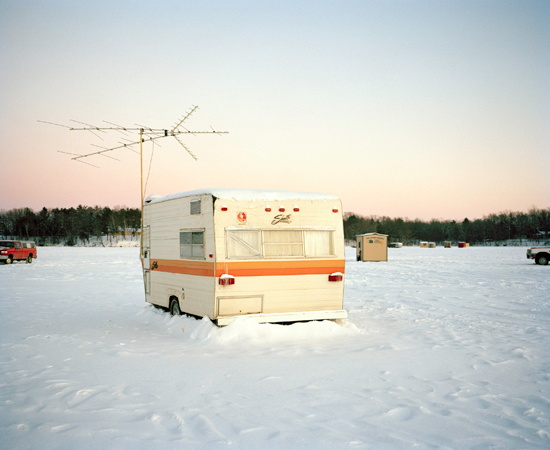
Image credit: From Maureen R. Drennan
H/T to Artist as Citizen Burning Embers Competition
On the Viz. blog September 2009, I discussed Maureen R. Drennan’s photo series "Thin Ice,"
where Drennan proposes the potential losses to ice fishing with global
warming. I recently had an interview with Drennan about "Thin Ice" and being a finalist on the New York Times DotEarth blog/Artist as
Citizen Burning Embers Competition. We discussed remote places, the scale
of her project, the themes and the arguments of the photos, as well as the intersections
of photography and story.
“A small story about a greater problem”: Interview with Maureen R. Drennan
Viz.: I was
talking to a colleague about your series of photos. She said that when she thinks about visual rhetoric
and the environment, she thinks of Al Gore’s “An Inconvenient Truth.” She was struck by the contrast between
“An Inconvenient Truth” as a visual rhetoric piece and what your series of
photos are doing.
Drennan: With Al Gore’s movie, he was really trying to
hammer home this situation that is imminent, and I think he’s trying to reach
as many people as possible. I
think it was done very successfully.
It was done in a way where a lot of people could understand it. It was accessible, and it was also
dynamic and intense. I know my
work is not like that. I wouldn’t
know how to go about doing that.
That would be for a different photographer…I’m not a scientist. I don’t claim to be an expert.
Viz.: How do
you think your photos compare to the other visualizations of climate change?
Drennan: I hope
this doesn’t come across as self-deprecating. I think [my images] were a little more subtle. It’s not super dynamic, but I
think that’s okay. It’s a small
story that I think can relate to the big picture. We’re all involved in small stories. It’s what we’re involved in every
day. It makes up the big
picture. I think other
visualizations of climate change are grand and monumental. My pictures aren’t like that. They’re a lot more quiet.
Viz.: Can you
describe how you began to take these pictures of ice fishing?
Drennan: I’m
from Manhattan, born and raised here in New York. I’m really drawn to remote, beautiful places because it’s so
different from what I’m accustomed to.
My husband Paul is from Rice Lake, Wisconsin, which is a very small town
in northern Wisconsin. When
we would go visit his in-laws, I usually wander around and take pictures of the
area. I was just really drawn to these beautiful, remote lakes, and the fact
that there are these little shacks on the lake. [For people who aren’t from a cold climate, ice-fishing] is
sort of a foreign thing. I was
really drawn to it…What are they doing out there? Why are there these little houses out there on the lake? I
just instinctually wandered out there and started chatting with people and
taking their picture and taking photographs of the landscape and the ice
shacks.
What was initially so interesting was the community and how
tight knit they are: these
temporary communities out on the ice.
They only last a few months, and people bond. They become so close.
It’s like having a cabin in the summer at the lake. It’s a little place—a little refuge
that you go to—and you’re friends with the neighbors. You also (for safety
reasons) have to be looking out for one another. Even though it’s an isolated activity, there’s also a community
aspect.
Viz.: How did your photos become part of the Artist as
Citizen project?
Drennan: Even just in the two years that I have been doing
this, the season got a little bit shorter. The ice shacks went out later in the winter and came back
earlier. It’s way below zero—like
10 degrees below zero and 20 degrees below when the wind picks up—so I spend a
lot of time in the shacks talking to people. In talking to people this past winter, people [would say]
how the season is changing and the ice is changing…That’s anecdotal. I don’t think [the ice fishers are]
studying charts and graphs, but it was interesting to hear. It just got me thinking about these
lovely communities and how this is a small story about a greater problem.
For the full interview, click here.

Recent comments
2 years 29 weeks ago
2 years 44 weeks ago
2 years 44 weeks ago
2 years 50 weeks ago
3 years 4 weeks ago
3 years 4 weeks ago
3 years 4 weeks ago
3 years 6 weeks ago
3 years 6 weeks ago
3 years 6 weeks ago